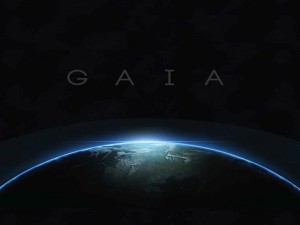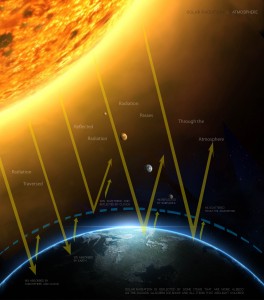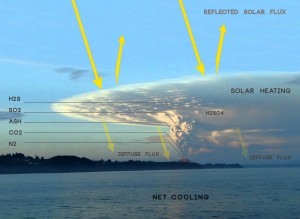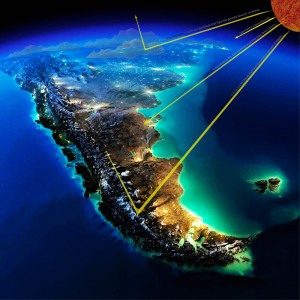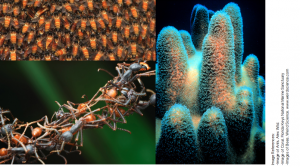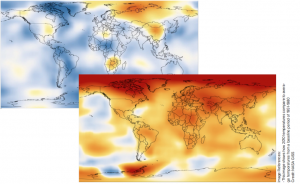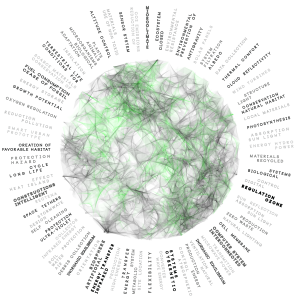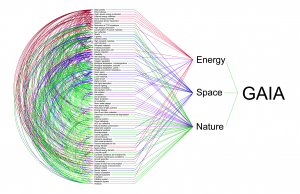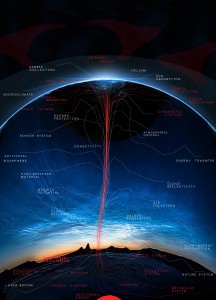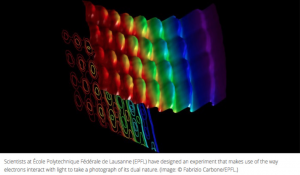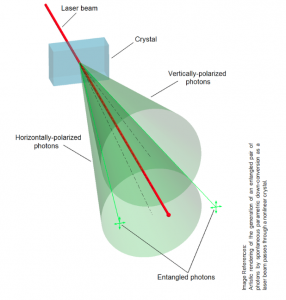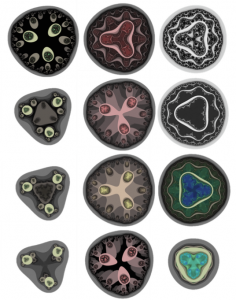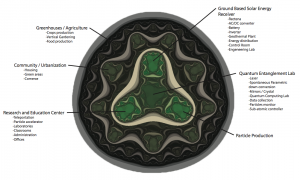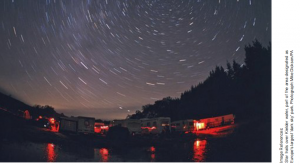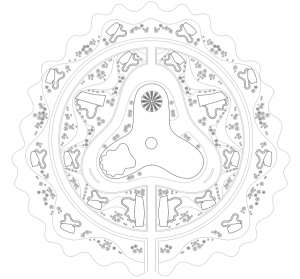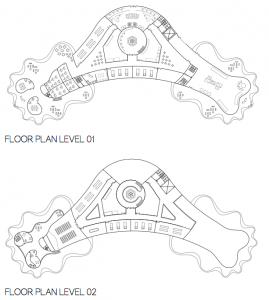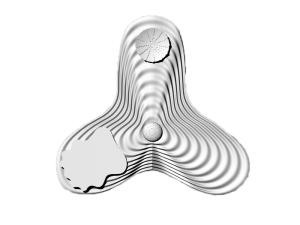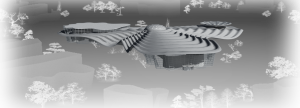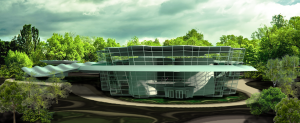“Evolving to Earth’s intelligence to rise up rooted, like trees”.
Industrial production remains a key driver for innovation, productivity, growth and job creation. Setting a vision and outline towards high added value research technologies for the Factory of the Future, which have to be environmental friendly, socially sustainable and highly performing. GAIA is a factory of knowledge, research and applications from the world of quantum mechanics; a space-based factory of solar energy production; and a factory of quantum entangled particles. GAIA proposes a way to hack the earth as super organism that is the planet from the smallest particles of matter to the atmosphere into applied quantum entanglement to revert the effects o the planet’s temperature rising from entangled particles sent to the atmosphere, to control and restore the depletion of the layers of the atmosphere. GAIA suggests a step closer for co-evolution of the human being with the world.
Gaia hypothesis
The ancient Greeks called her earth goddess or Gaia. Gaia was mother nature, gentle, nurturing but also ruthless to tho- se who crossed her. The hypothesis of Gaia was formulated by James Lovelock defining the planet Earth as a complex entity, involving earth’s biosphere, atmosphere, oceans and soil in a cybernetic system that seeks the chemical and physical equilibrium that contributes to maintaining the conditions necessary for life on the planet.This theory hoy the biosphere and the evolution of life forms affect the global temperature, ocean salinity, oxygen in the atmosphere, global warming and environmental factors that affect the living conditions of Earth.
The Earth’s atmosphere is an unusual and unstable mixture of many gases, thus life is present. Earth’s gas is not on chemical equilibrium, yet appears it maintains in a constant state, that suggests a regulation of the planet’s atmosphere.
An example is how the activity of photosynthesis of the plants, bacteria and phytoplankton influence the exchange of gases between the atmosphere and the sea. The process of converting light energy to chemical energy and storing it in the bonds of sugar. Plants need only light energy, carbon dioxide, and water to produce oxygen. Animals and humans need oxygen to live, through respiration inhaling oxygen and exhaling carbon dioxide.
The interaction of the atmosphere with the ocean is one mechanism that is the release of cloud condensation nuclei, phytoplankton. When the sun is shining brightly, phytoplankton grows rapidly and produces air born particles. When water vapor in the atmosphere condenses or freezes around these particles or nuclei, clouds form. The increasing clouds, lowers the temperature on the earth but also blocks the sunlight to the phytoplankton, the phytoplankton grows more slowly, fewer clouds are formed and the temperature of the earth rises. Phytoplankton provide the base of the marine food web, they also help the planet to breathe, through photosynthesis, phytoplankton produces half of the oxygen on earth that all the animals and humans need to live.
As the atmosphere is a complex mixture of gases, volcanoes contribute in a huge way. The principal components of volcanic gases are water vapor (H2O), carbon dioxide(CO2), sulfur either as sulfur dioxide (SO2). When pressure builds up, eruptions occur. Gases and rock shoot up through the opening and spill over or fill the air with lava fragments, injecting all these components to the atmosphere.
This activity during Precambrian times have completely modified Earth atmosphere turning it aerobic, and such supporting evolution of life. Each individual species pursues its own self-interest, their combined actions. This view reference examples of events that results in dramatic change instead of a stable equilibrium, like the conversion of the Earth‘s atmosphere from a dead or reduced environment to an full and rich one.
The biosphere regulates the climate, is like the internal maintenance of our bodies. Our body temperatures are maintained by feedbacks between the brain and various organs and systems in the body. If it is too cold, our bodies produces heat by shivering, if it’s too warm, our body sweat and remove heat through evaporation. On earth, temperature is regulated in a similar fashion. Albedo refers to the color of the planet and its ability to absorb or reflect light. Dark areas absorb energy from the sun; light areas like clouds or polar ice caps reflect the sun’s energy away from the earth. Global temperature is regulated by clouds, if there are more clouds, more sunlight is reflected and the earth cools, fewer clouds, more sunlight reaches the surface and the earth warms.
Lovelock states that the Earth is alive considering the planet as a single living organism. Super-organisms are important in cybernetics, they exhibit a form of “distributed intelligence,“ a system in which many individual agents with limited intelligence and information are able to pool resources to accomplish a goal beyond the capabilities of the individuals.
Bees are a good example of super-organisms. Where would we be without bees? They are critical pollinators, over the 100 of crops species that feed 90% of humanity, more than 70 of them are pollinated by bees. If we lose bees, we would lose the plants that they pollinate, all the animals that eat tho- se plants and ultimately up the food chain to us. The evolution of life and its environment may affect each other.
While energy flows through the earth, matter cycles within the earth. Everything that happens on the planet, the life and death of the trees, the increasing or decreasing of emissions of carbon dioxide, the planting of croplands, all have an im- pact on the planet. If the earth is not itself regulated, then will adjust to the impacts of the man. These adjustments may act to eventually decrease and limit our numbers or to exclude man, all together. The cycle continues in a self-regulating and balanced manner. The earth must recycle elements to make them available for other processes, otherwise the whole sys- tem would run down and the earth would be as dead as the moon.
Overwhelming Gaia with overpopulation, our toxics or our demands in the planet, Gaia will act to bring us back in to ba- lance with nature. It gives a responsibility for the maintenance of the health of the planet and to ourselves.
The hypothesis has been criticised for contradicting the principles of natural selection and to the fact that the planet can not reproduce itself like all living organisms. But Lovelock suggests that global biological feedback mechanisms could evolve by natural selection, that organisms can improve the environment for survival better to those that damage the environment. Gaia is an alternative to that depressing picture of our planet as a lonely spaceship forever traveling purposeless around circles with the sun. Gaia proposes an endless future for life.
Inputs
For a project to be self-sufficient means that it has no need of outside help in satisfying it‘s basic needs. This regards to all the aspects that a building needs to meet in order to be self- sufficient, using processes that are environmentally responsible and resource-efficient throughout a building‘s life cycle from the design, construction, operation, maintenance, renovation to the deconstruction.
Related to the Gaia hypothesis research and understanding, the development of what the project is operated on processes and systems that enters to a cycle that will protagonize the 80 inputs of the building.
The inputs are divided in three main topics: Nature, space and energy. Taking into consideration climate conditions, ecosystems, building structure, renewal energies, materials, waste management, building placement, production and research.
Factory layout
The basic objective of the layout of a factory is to under- stand the function of the factory for in efficient production environment and to provide guidance on laying out the functions and facilities in a factory, based upon the decisions about the type of manufacturing process to be accommodated. This layout determines the way in which the inputs flow through the operation.
The factory will consist in two manufacturing processes in a linear form and a factory of knowledge. First process is the matter of space-based solar energy, which is the concept of collecting solar energy in space using a “solar-power satellite“ for use on Earth. SBSP converts sunlight into microwaves outside the atmosphere, avoiding the loss and downtime of solar energy production during night due to the Earth‘s rotation.
The second process consist on the production of particles on Earth, entangle the particles through spontaneous parametric down-conversion and send them to the satellite receptor or- biting in the atmosphere with a laser, where at the same time will change its properties and disperse the particles into the atmosphere to heal the damaged layers. This process will implemented in collaboration the factory of knowledge, where education, knowledge, engineering and technology will work together to apply the quantum mechanics into the factory.
Quantum physics
Quantum physics is the foundation for most of the modern technology, providing a framework for understanding matter and light from the atomic and subatomic level. Quantum physics provides a mathematical description of the dual particle-like and wave-like behaviour and interactions of energy and matter.
“It seems as though we must use sometimes the one theory and sometimes the other, while at times we may use either. We are faced with a new kind of difficulty. We have two contradictory pictures of reality; separately neither of them fully explains the phenomena of light, but together they do“. Albert Einstein
Light behaves as both a particle and a wave at the same time, this concept called “Wave-particle duality“. This concept displays the fundamentally probabilistic nature of quantum mechanics phenomena. The double-slit experiment demonstrates that a light beam illuminates a plate pierced by two parallel slits and passing through the slits, the light is found to be absorbed at the the screen at specific points, as individual particles, finding each photon passes through one slit, and not through both slits. The results are demonstrating the principles of the “wave-particle duality“.
Another example is the Quantum Leap refers to a behaviour of the electrons from one quantum state to another within an atom. Electrones have fixed orbits in its atom like the planets on a solar system, but they have transitions or “jumps“ from one orbit to another almost immediately. On every transition the electron makes, emites electromagnetic radiation in the form of photons. The larger the energy separation of each orbit the electron jumps, the shorter the wavelength of the photon is emitted.
Quantum entanglement
Einstein thought he found the Achilles heel of quantum mechanics, the most strange and bizarre of theoretical predictions he thought that he held the key to proving that the theory was incomplete, it is called “entanglement“.
Entanglement is a theoretical prediction comes from the equations from quantum mechanics. Two particles can become entangled if they‘re closed together and their properties become linked. Even if the particles are separated they can remain entangled and inexplicably connected. To understand how this is possible, we need to measure the particle spin. For example, if one particle is measured and it‘s spinning clockwise, without measuring the other particle we can know that it will be spinning counterclockwise, even if they are thousands of kilometres away. For Einstein, that kind of weird long-range connection called it “Spooky action at a distance“.
Several experiments had tested quantum entanglement with spontaneous parametric down-conversion or “SPDC“, used to entangle photons. By firing a beam of photons into a splitter that cuts each photon in two, sending half of the light to one lab and the other half to another lab. A finely tuned homodyne detector is used to measure the waves of these particles.
Conceptual design process
A fractal is a mathematical set or a natural phenomenon that shows a never-ending pattern that repeats itself at every scale. They are created by repeating a simple process over and over again in an ongoing feedback loop. This suggests a set of dynamic systems. Since nature is full of fractals, they are very familiar. We can find it in plants, seashells, mountains, etc.
Relative to this art form, they are complex computer genera- ted images or designs using mathematical formulas, and are infinite in their ability to be viewed in ever increasing detail.
While using Processing, a programming language, to genera- te a script setting up the sketch properties, I was able to generate “fractal cells“. This software is a useful tool for today professionals for prototyping and production. The evolution in the process of designing suggests a solution in enhancing and changing its structure and capabilities incrementally. Transforming the radius, mapping the screen space to complex space and map the complex space back to the screen space, by calculating the set of colours and feed back, you can get a user interaction and show the image evolving into different shapes, patterns and colours.
GAIA – Factory of the Future
This project consists in a small community site based on the layouts and exploration on the concept of fractal cell. Creating a layout of different colours and shapes that gives a logic and order in the distribution of spaces. This community along with GAIA will support itself by producing their own food through urban greenhouses and agriculture; the energy produced by SBSP of 1 square kilometres will produce enough energy to the community and to provide energy to near cities.
GAIA will be located in Northumberland, UK. This place is Eu- ropes‘s largest area of protected night sky. Due to its pristine skies it was awarded gold tier designation by the International Dark Sky Association. Which could be considered one of the greatest place for GAIA‘s research.
The core building is located in the center of the cell, as housing, agriculture, equipment and market develops around it following the pattern and logic of the fractal cell. Laying out a factory involves deciding where to put all the facilities, ma- chines, equipment and staff in the manufacturing operation.
Relatively small changes in the position of a machine in a factory can affect the flow of materials considerably. This in turn can affect the costs and effectiveness of the over- all manufacturing operation.
In cell layout, the materials and information entering the operation are pre-selected to move to one part of the operation (or cell) in which all the machines to process these resources are located. After being processed in the cell, the part-finished products may go on to another cell. In effect the cell layout brings some order to the complexity of flow that characterises process layout.
The roofing concept comes from the oscillation of the waves of a photon, creating a cosine wave oscillation to basic shape of the cell. This light structure will be supported by the walls and cover large areas without more structural support.
Establishing a close relationship of the students and the professional world is very important. Mentoring, coaching, and collaboration are shared processes, a shared journey of commitment to effective practice and improved learning for all students. This will allow a better functionality of GAIA for developing new ideas, technologies and research.
GAIA proposes a co-evolution of the architecture and human being with the environment and the planet, the practice of self-sufficiency to the environmental consciousness and the driver for innovation and new technologies emerging.

